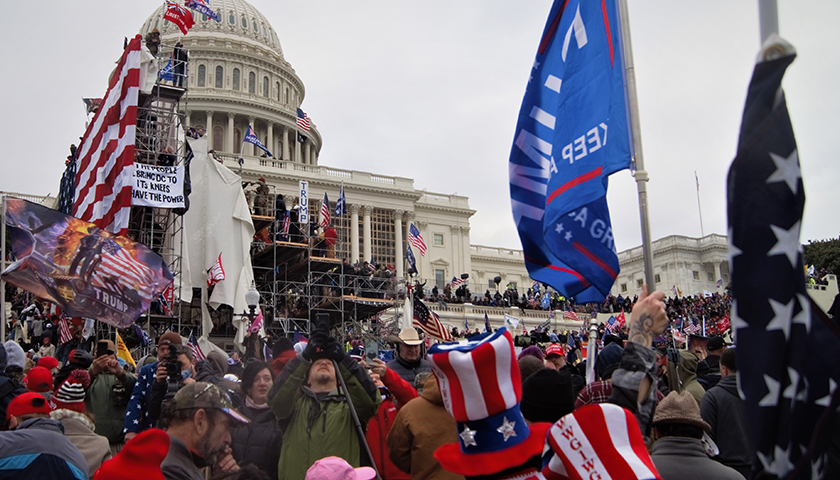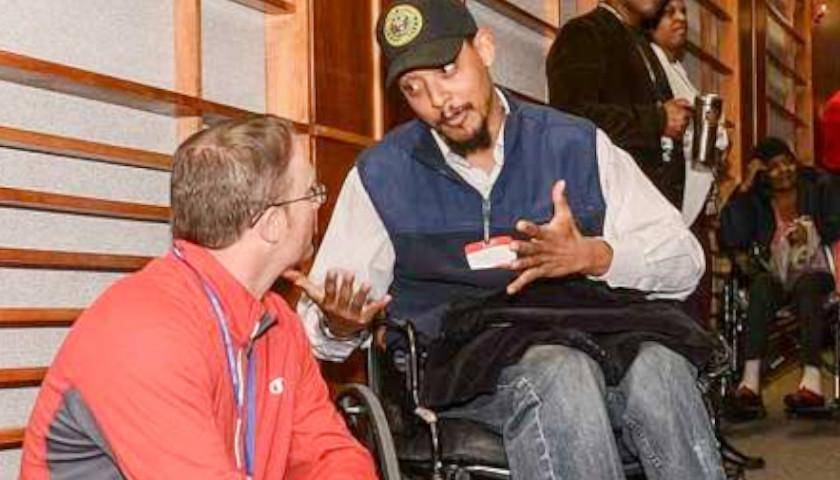by Julie Kelly
George Tanios’ fiancée encouraged him to go to Washington on January 6 to hear President Trump’s speech. “You’re gonna regret it if you don’t go,” she said, hoping he could take a break from working 100-hours-a-week to run his popular sandwich shop in Morgantown, West Virginia.
Tanios and I both laughed after he told me that during a two-hour interview this week. (I was in contact with his fiancée, Amanda, as she cared for their three young children while he was incarcerated for five months.)
But there is nothing funny about how Joe Biden’s Justice Department is trying to ruin Tanios’ life to maintain the myth that Capitol Police Officer Brian Sicknick died at the hands of Trump supporters on January 6.
Tanios, 40, was arrested in front of his five-year-old son at home on Sunday, March 14 around 9 p.m. “I was about to get in the shower and had my robe on when I heard crazy banging on my front door,” he said. “Then I heard ‘put your fucking hands up!’”
About 15 FBI agents and the acting head of the U.S. Capitol Police raided his home, interrogated Amanda, and took Tanios into custody.
“I had no idea what I was being arrested for,” Tanios said. “No one would answer me. Some of the agents seemed to feel bad about it. One [agent] said they had been arresting people all over but they had never arrested anyone without a criminal record like this.”
Tanios was held in jail for four days before his attorney arrived and informed him of the charges related to Sicknick, including one count of conspiracy to injure an officer and three counts of assault on a federal officer with a dangerous weapon—chemical spray.
“I almost had a heart attack,” Tanios said. “I begged them to take the handcuffs off me because my heart dropped. ‘I am not a cop killer,’ I said.” Tanios had heard an officer had been killed on January 6, but that’s all he knew.
What Tanios also did not know at the time was he and his friend, Julian Khater, would become the scapegoats for one of the biggest lies about the Capitol protest; the claim that Trump cultists killed a cop in cold blood on January 6.
Reports of Sicknick’s death in the immediate aftermath of the Capitol protest served two purposes: to bury the news that a Capitol Police officer had killed an unarmed female Trump supporter in the building on January 6, and to fuel more public outrage about a “deadly insurrection.”
Adding to the shocking news, the New York Times reported on January 8 that Sicknick “died from brain injuries he sustained after Trump loyalists who overtook the complex struck him in the head with a fire extinguisher.”
The anonymously sourced account went viral; no other news organization bothered to check its veracity. Ditto for most Republican lawmakers. “Neither the institution of Congress, nor the American people, will ever forget the bravery and the valor of officer Brian Sicknick, who sacrificed himself to protect this place and those inside it,” Senate Minority Leader Mitch McConnell (R-Ky.) said on January 19.
Heartbreaking images from a formal procession through the nation’s capital to a rare memorial service in the Capitol rotunda were splashed across cable news and the front page of every newspaper and online publication. Joe and Jill Biden offered their respects to Sicknick as his remains lay in repose in early February, days before the second impeachment trial against Donald Trump began.
House Speaker Nancy Pelosi (D-Calif.) and Senate Majority Leader Chuck Schumer (D-N.Y.) both spoke during a somber service attended by every prominent lawmaker; Sicknick’s remains were then transported to Arlington National Cemetery.
But the Times retracted the “fire extinguisher” story, which was featured as evidence in the impeachment trial, on February 12. The cause of Sicknick’s death remained an open question; the D.C. Medical Examiner’s Officer refused to release official autopsy results.
With so many powerful people and news organizations fully invested in the murder-by-MAGA-mob narrative, a new excuse to blame Trumpists for Sicknick’s death was quickly concocted.
Enter George Tanios and Julian Khater.
On March 15, the Justice Department announced in a press release that the pair had been arrested for spraying Sicknick and two other officers. The latest twist, eagerly echoed by the media, was that Sicknick died of a reaction to chemical spray.
Even though Tanios wasn’t accused of using the pepper spray—he told me they brought the spray to Washington over fears Antifa and Black Lives Matter activists would attack Trump supporters as they did after the Million MAGA March on November 14, 2020—a magistrate judge denied bond on March 22. “I don’t think I have ever seen anything play out in a way that was more dangerous to our community,” Judge Michael Aloi said of the Capitol protest.
In May, D.C. District Judge Thomas Hogan, a Reagan appointee, again denied Tanios’ release. Tanios and Khater, Hogan said, “attacked uniformed police officers and I can’t get around that.”
For four months—the first month was spent in West Virginia jails—Tanios lived at the D.C. Correctional Treatment facility, part of which is used solely to detain January 6 defendants. He described to me, as many have, the overall camaraderie between the detainees. “I found my tribe there, like-minded individuals who love their country and support the flag like I do,” Tanios said. “The guys in there supported Trump because he was an outsider. We finally felt like we had an outsider fighting for us.” But many were in D.C. on January 6 to protest a rigged election, not necessarily to support the president. “They didn’t cheat him, they cheated us,” he told me.
Occasionally, the atmosphere with Tanios becomes tense. “People are being wrongly accused, they can’t get any response from their lawyers and judges keep kicking things down the road,” Tanios said. Detainees have reported lack of access to defense counsel, personal hygiene needs, religious services, and exercise. For months, detainees were kept in their cells for 23 hours a day.
While Tanios was behind bars, the medical examiner’s office in April finally confirmed the cause of Sicknick’s death. He died of natural causes—two strokes caused by blood clots—not from an allergic reaction to any chemical.
Tanios received rare good news on August 9 when the D.C. Circuit Court of Appeals reversed Hogan’s detention order. (The court denied Khater’s appeal.) “We conclude that the district court clearly erred in determining that no condition or combination of conditions of release would reasonably assure the safety of the community.”
Tanios went home on August 20. But he’s far from free. Tanios has been on home incarceration for more than seven weeks and can’t work until a judge relaxes the terms of his release. The sandwich shop he operated for years has been shuttered since March; he thinks he can sell the equipment inside but not the restaurant itself.
“Who is going to buy a business with this name attached to it?” he asked.
Like every January 6 defendant, Tanios’ reputation has been crushed until he has a chance to clear his name in court. The day after his arrest, Airbnb sent Tanios an email with a link to a Washington Post article about him to explain why his account had been deactivated. DoorDash deplatformed his business in April.
“In the court of public opinion, we’ve all been destroyed,” Tanios told me. “The truth is going to come out, though, it has to.” No trial date, however, has been scheduled.
Unfortunately, millions of Americans will continue to believe Tanios somehow is responsible for what happened to Brian Sicknick, just like millions of Americans still believe Sicknick was killed in the line of duty by “insurrectionists.” Confronting a biased Beltway legal system is only half the battle for January 6 defendants; the court of public opinion is far less judicious or fair-minded.
– – –
Julie Kelly is a political commentator and senior contributor to American Greatness. She is the author of Disloyal Opposition: How the NeverTrump Right Tried―And Failed―To Take Down the President. Her past work can be found at The Federalist and National Review. She also has been featured in the Wall Street Journal, The Hill, Chicago Tribune, Forbes, and Genetic Literacy Project. She is the co-host of ‘Happy Hour podcast with Julie and Liz.’ She is a graduate of Eastern Illinois University and lives in suburban Chicago with her husband and two daughters.
Photo “Jan. 6 Capitol Riot” by Tyler Merbler CC BY 2.0.




